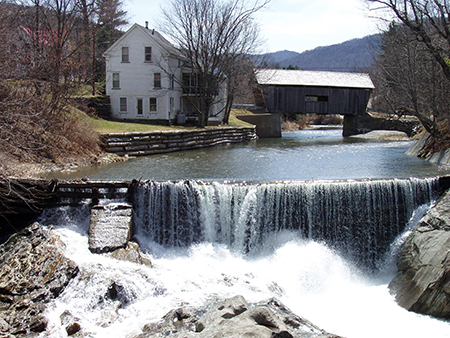
On Tuesday, November 27, Mac Rood and Ellen Strauss of the Warren Village Dam Preservation Trust asked the Warren Select Board for their support in preserving the historic timber crib dam in Warren Village.
Once an integral part of the bustling mill town, the 200-year-old dam has started to deteriorate and getting permission to repair it “is going to be difficult,” Rood said.
The dam is currently owned by the preservation trust, but the trust must first obtain a stream alteration permit from the Vermont Agency of Natural Resources (ANR) before it can start to repair the structure. Unfortunately, repairing dams “isn’t a high priority for the ANR,” Rood said.
“In fact, it’s an anti-priority,” Strauss explained, as the agency generally works to remove all non-operational installations in order to return rivers to their natural states.
While removing the dam could be better from an environmental standpoint, from a historical—and emotional—standpoint it would forever alter the face of the town.
“[The dam], it could be argued, is an essential part of the single most important resource in the town: its beauty,” Gregory and Carolyn Schipa wrote in a My View letter to The Valley Reporter last month.
Indeed, the dam and its resulting mill pond and waterfall have become an almost “iconic” image of Warren, Rood said, pulling out a stack of postcards displaying the picturesque scene.
Regardless of the dam’s incalculable aesthetic value, repairing the dam could have practical merit.
While the town of Warren is not responsible for the dam’s upkeep, it is responsible for the upkeep of the covered bridge just upstream of it, “and we don’t know what would happen to the foundations of the covered bridge if the dam weren’t there,” select board chair Andy Cunningham said.
But could the dam’s continued existence also contribute to flooding upstream? It’s possible, Rood explained.
In the end, one must weigh the effects the dam’s preservation could have on the environment versus the effects it could have on the local community. “ANR has a lot of weight on river health,” Strauss said, “but we also live here and this is our village.”
The select board agreed to write a letter in support of the trust and its efforts to preserve the dam.
Warren Fire Department update
Peter DeFreest came next before the board to discuss plans for repairing the Warren Fire Department’s E1 truck.
The truck was built with black iron piping that is now leaking and while the truck was recently appraised at only a $30,000 value, “it was custom built for here and we like it,” DeFreest said.
Instead of spending between $400,000 and $500,000 on a new truck, the department is looking into replacing the plumbing with either stainless-steel piping (which would cost about $20,000) or new black iron piping (which would cost about $10,000, and could last another 20 years).
There is some uncertainty over whether—if the plumbing is repaired—the truck’s frame will last in the long term and, currently, the opinions within the firehouse about the most cost-effective solution remain divided. “Some guys want to do one thing, some guys want to do another,” DeFreest said. “We talk about it and it gets a little heated.”
In the end, the board suggested that the department bring in an independent analyst to appraise the trucks and advise them on their best course of action. Board members also suggested that—within the next couple of years—the department plan for more long-term plan for repairs and replacements, so as not to surprise the board with any sudden requests for $500,000.
{loadnavigation}





